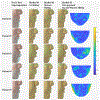A New Approach of Predicting Facial Changes following Orthognathic Surgery using Realistic Lip Sliding Effect
- PMID: 31886472
- PMCID: PMC6934101
- DOI: 10.1007/978-3-030-32254-0_38
A New Approach of Predicting Facial Changes following Orthognathic Surgery using Realistic Lip Sliding Effect
Abstract
Accurate prediction of facial soft-tissue changes following orthognathic surgery is crucial for improving surgical outcome. However, the accuracy of current prediction methods still requires further improvement in clinically critical regions, especially the lips. We develop a novel incremental simulation approach using finite element method (FEM) with realistic lip sliding effect to improve the prediction accuracy in the area around the lips. First, lip-detailed patient-specific FE mesh is generated based on accurately digitized lip surface landmarks. Second, an improved facial soft-tissue change simulation method is developed by applying a lip sliding effect in addition to the mucosa sliding effect. The soft-tissue change is then simulated incrementally to facilitate a natural transition of the facial change and improve the effectiveness of the sliding effects. A preliminary evaluation of prediction accuracy was conducted using retrospective clinical data. The results showed that there was a significant prediction accuracy improvement in the lip region when the realistic lip sliding effect was applied along with the mucosa sliding effect.
Figures






References
-
- Kim H., et al.: Anatomically-Driven Soft-Tissue Simulation Strategy for Cranio-Maxillofacial Surgery Using Facial Muscle Template Model. MICCAI 2010. 13(Pt 1), 61–68 (2010) - PubMed
Grants and funding
LinkOut - more resources
Full Text Sources
